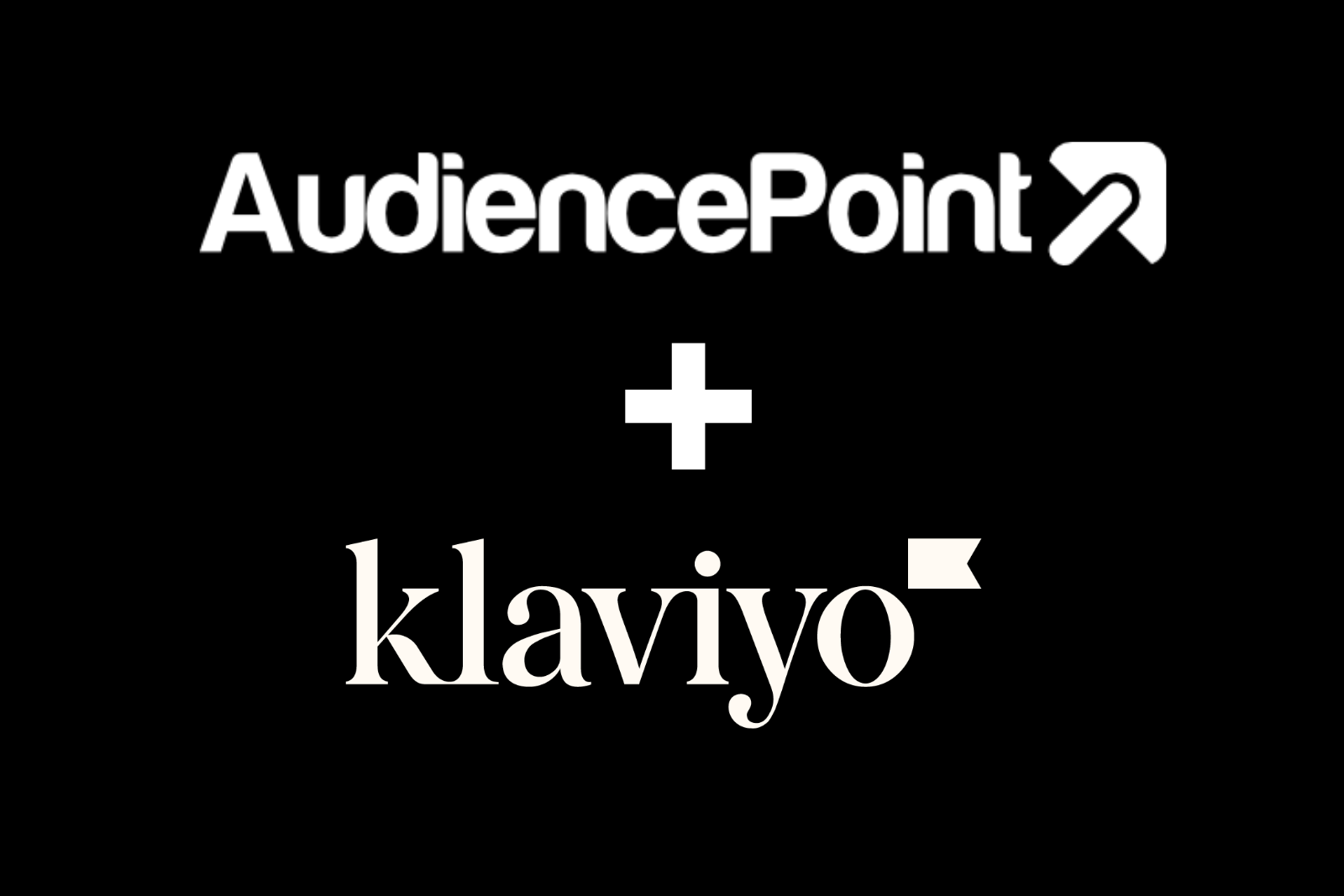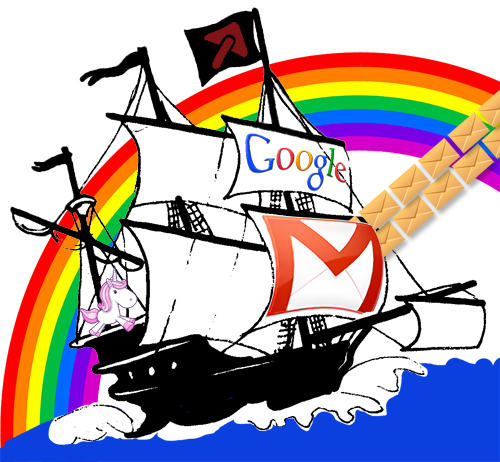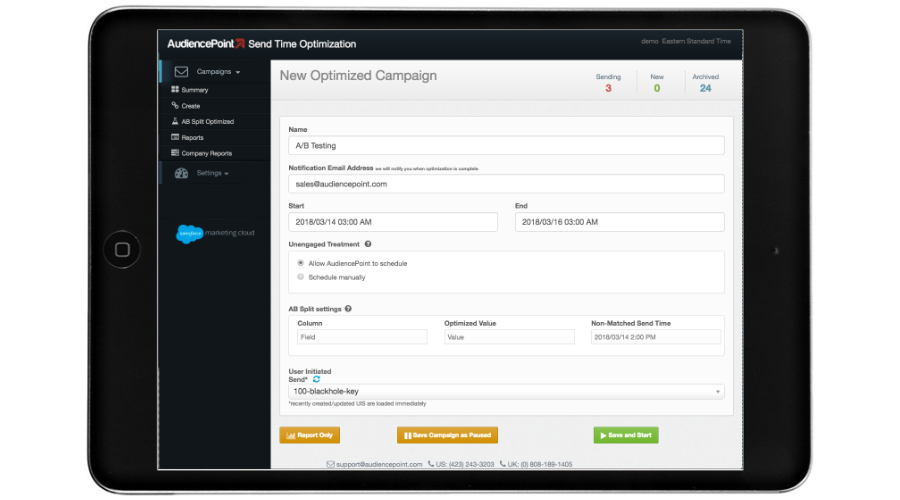AudiencePoint is thrilled to announce our new integration with Klaviyo! AudiencePoint is looking for partners to pilot our...
What Is EDM and How Does It Work?
Electronic Direct Mail (EDM) marketing is a powerful digital strategy that enables businesses to deliver targeted, personalized communications directly to subscribers via email. Unlike generic marketing blasts, EDM focuses on careful list segmentation, content curation, and leveraging data-driven insights and AI in Email Marketing to nurture customer relationships at scale. As a cornerstone of modern digital marketing, EDM’s effectiveness lies not only in reaching inboxes but in driving engagement, fostering loyalty, and generating measurable results from highly curated email campaigns.nerating measurable results from highly curated email campaigns.
At its core, EDM marketing involves a strategic workflow encompassing several key components. First, it begins with robust list building, ensuring you’re targeting the right audience based on explicit permissions, preferences, and behaviors. Next, content creation ensures each message conveys value, resonates with segmented audiences, and maintains consistent branding. Once content is crafted, marketers use scheduling tools to deliver campaigns at optimal times, maximizing open and click rates. The final—and most critical—stage is analysis, where advanced platforms like AudiencePoint provide granular insights into deliverability, inbox placement, engagement, and overall campaign performance.
Marketing professionals are increasingly leveraging automation to streamline these processes. With workflow automation, brands can trigger messages based on user actions, automate follow-ups, and ensure personalized content reaches each subscriber at the right moment. This not only improves efficiency but also achieves higher conversion rates by aligning messaging with real-time customer journeys.
What is a Drip Campaign in Email Marketing: Popular EDM Marketing Examples and Use Cases?
Effective EDM marketing examples include welcome series for new subscribers, welcome email as the initial message sent to onboard and build trust with new subscribers, product launch announcements, abandoned cart reminders, loyalty program updates, and re-engagement campaigns to re-engage inactive segments. Reviewing real-world campaign examples can provide valuable inspiration and guidance for designing effective EDM strategies tailored to your audience and goals. Industry case studies reveal that brands using advanced tools to optimize inbox placement and engagement—like those powered by AudiencePoint—achieve up to 15% higher open rates and a dramatic reduction in spam placement by actively suppressing or reactivating segments based on real subscriber signals.
Popular blog posts are often included in nurturing sequences to drive engagement and encourage conversions throughout the customer journey.
With today’s EDM technology advancing rapidly, marketing teams must look beyond basic delivery metrics. Monitoring click through rate is crucial, as it serves as a key indicator of campaign effectiveness and subscriber engagement. Platforms that monitor every inbox signal ensure accuracy, helping marketers prevent wasted sends and maintain stellar sender reputations. In a competitive landscape, investing in advanced tools to monitor and boost inbox placement is essential for long-term success and measurable ROI from EDM.
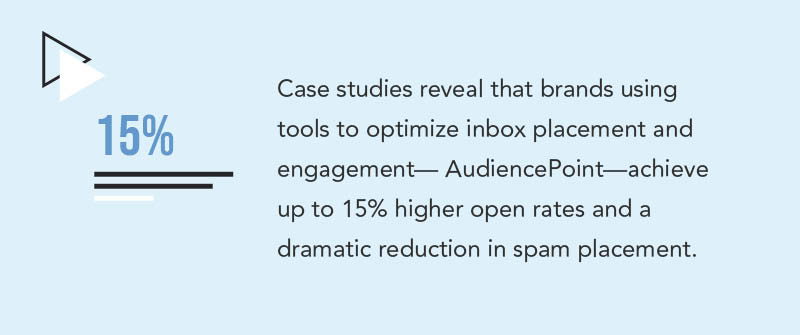
How Does Direct Mail Marketing Work?
Direct mail marketing—whether delivered physically or electronically—operates on the foundational principles of reaching targeted recipients with compelling, personalized messages and personalized emails designed to provoke engagement and drive conversion, often by including a clear call to action in each message. While traditional direct mail refers to physically mailed promotional materials, Electronic Direct Mail (EDM) harnesses the reach, efficiency, and data-driven capabilities of digital platforms to deliver relevant content to recipients based on their preferences or behaviors, making it an increasingly preferred channel for modern marketers seeking scale and measurable impact.
Steps in Developing an EDM Campaign: From Design to Delivery
An effective EDM campaign begins with audience segmentation, ensuring messages are tailored to recipients who are most likely to respond. This is followed by crafting engaging and visually appealing content, a process where Electronic Direct Mail Design best practices become crucial. Marketers leverage EDM marketing templates to streamline email creation, maintain brand consistency, and accelerate deployment. Automation tools send campaigns at optimal times based on behavioral data, which is vital for maximizing engagement rates. An email sequence can be scheduled to deliver messages at predetermined intervals, guiding prospects through various stages of the customer journey. A well-designed drip sequence ensures consistent engagement and nurtures leads throughout the entire process.
Best Practices for Electronic Direct Mail Design
ROI-driven EDM design prioritizes mobile-friendly layouts, concise messaging, and attention-grabbing visuals. To maximize engagement, it is essential to keep messaging relevant to the recipient’s interests and needs. Personalization techniques—ranging from dynamic images to recipient-specific offers—increase open and click-through rates. Crafting compelling subject lines and testing different subject line variants are crucial for optimizing open rates and overall campaign performance. Clear calls-to-action (CTAs) are non-negotiable, guiding recipients toward desired actions. Effective EDMs maintain brand consistency across touchpoints, reinforcing familiarity and trust.
Utilizing EDM Marketing Templates for Efficiency
EDM marketing templates empower marketing teams to launch campaigns faster while upholding best-practice formatting and compliance. Many templates also include helpful tips for optimizing design and content, making it easier to create effective and engaging campaigns. Leveraging modular templates also allows for rapid A/B testing, so marketers can experiment with various designs and content to learn what resonates most with their audience. Modern EDM platforms further simplify collaboration, reduce design bottlenecks, and support scalable operations suitable for enterprise-level deployment.
Measuring Drip Campaign Success: Inbox Placement, Engagement, and Conversions
Deliverability is only the beginning—real success hinges on inbox placement, engagement, and conversions. With innovations such as AudiencePoint’s advanced inbox placement monitoring, marketers now gain detailed insights into whether their EDMs land in the inbox or spam folder. This data-driven visibility is essential, as studies show that even a small decline in inbox placement can severely impact campaign ROI.
To measure success, it is important to define clear drip campaign goals that align with desired customer actions and lead nurturing strategies. By monitoring open rates, click-through rates, and conversions, marketers can iteratively optimize campaigns for superior performance, ensuring an effective drip campaign that delivers measurable results. Insights gained from current campaigns should be used to refine and improve future campaigns, driving ongoing marketing success.
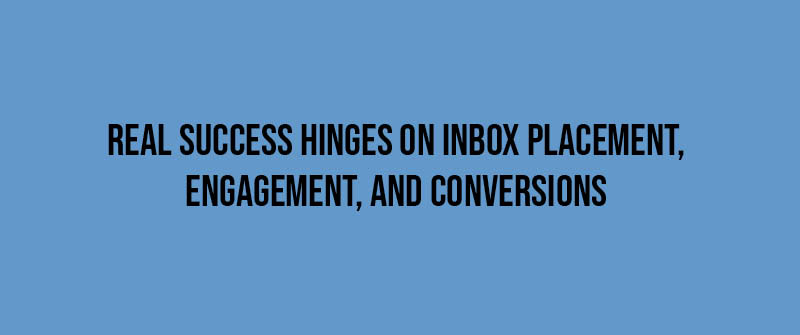
What Is the Difference Between EDM and Email Marketing?
EDM (Electronic Direct Mail) marketing is often confused with standard email marketing, but they represent fundamentally different approaches to customer outreach. While both deploy email as a central communication tool, EDM marketing encompasses a multi-channel, data-driven strategy that weaves together automated workflows, audience segmentation, and cross-channel integration, whereas email marketing typically refers to single, often isolated email blasts or nurture campaigns. The vital distinction lies in the breadth, sophistication, and multi-touch cadence of EDM versus the narrower, email-only focus of traditional email marketing. A comprehensive email marketing strategy often incorporates drip marketing and drip marketing campaign elements, using scheduled, targeted sequences to nurture leads and re-engage customers.
To illustrate, EDM marketing is more of a holistic orchestration: it connects emails with SMS notifications, push messages, social media retargeting, and even direct mail, forming a robust lifecycle journey that adapts to subscriber behaviors across platforms. Automation and integration in EDM frequently rely on automated email to deliver timely, personalized messages triggered by user actions across channels. A sophisticated EDM campaign draws data from various customer touchpoints for personalization and engagement, often leveraging audience insights from tools like AudiencePoint to increase inbox placement and open rates—crucial when platform algorithms are growing stricter and consumer inboxes are getting more crowded.
How Does EDM Compare to Basic Email Marketing?
EDM marketing campaigns employ richer design, automation, and integration capabilities. For example, while a traditional email marketing campaign may send a generic newsletter to a broad audience every month, an EDM strategy could segment that audience to identify the target audience, deliver hyper-personalized messages triggered by behavioral signals, and synchronize an email send with a follow-up SMS or a tailored web retargeting ad. Automated emails play a crucial role in maintaining consistent communication and engagement with each segment. Additionally, an email drip campaign or email drip can be strategically used to nurture the target audience with personalized content over time, guiding them through the customer journey and increasing conversions. This unified approach delivers higher relevance, enabling brands to reach customers in the right place at the right time—maximizing engagement and ROI.
Modern EDM marketing design focuses on delivering seamless multi-channel experiences through automation platforms. Practical elements include advanced dynamic content, journey mapping, and tight CRM/data platform integrations. Marketers using AudiencePoint can benefit from predictive insights into inbox placement and subscriber engagement across devices—capabilities that far surpass the limited analytics typically offered by conventional email solutions.
Why Should Marketers Evolve From Email Marketing to EDM?
Sticking with simple email marketing exposes brands to better-performing competitors using robust EDM strategies. Modern inbox algorithms prioritize relevant, engaging content—meaning marketers must now master both deliverability and placement. Tools like AudiencePoint give professionals visibility beyond “delivered” status by revealing true inbox placement. Understanding how drip campaigns work—by delivering targeted, automated messages over time to nurture leads and build relationships—can be a game changer. A successful drip campaign, which leverages personalization, segmentation, and ongoing optimization, can significantly boost engagement and conversion rates compared to traditional email marketing. With remarkable data showing that even a slight increase in inbox placement can represent a substantial uptick in conversions and revenue, the shift from traditional email marketing to holistic EDM becomes not just a recommendation but a necessity for growth-focused teams.
What Is the Difference Between CRM and EDM?
The distinction between CRM (Customer Relationship Management) and EDM (Electronic Direct Mail) is essential for email marketing professionals aiming to optimize campaign performance and subscriber engagement. While EDM refers to the act of sending targeted marketing emails or messages directly to customers, CRM is the underlying system that manages and analyzes customer data, powering tailored EDM campaigns. CRM data enables effective lead nurturing and lead nurturing campaign strategies by delivering valuable, targeted content over time to develop relationships with prospects and re-engage existing leads. Understanding the customer journey and sales funnel is essential for designing targeted EDM campaigns that guide prospects through each stage, ultimately converting leads into customers. Effectively, CRM is the strategic software backbone, and EDM is one of the main tactical outputs fueled by it. Businesses that blend both see significantly improved targeting, personalization, and, as a consequence, campaign ROI.
How Do CRM Systems Empower EDM Campaigns and Customer Relationships?
CRM systems are indispensable in the world of EDM marketing because they provide a centralized repository for customer data—purchase histories, interactions, preferences, and behaviors. When integrated with an EDM platform like AudiencePoint, CRM systems allow marketers to segment audiences with precision, trigger behavior-based automations, and deliver hyper-personalized content at scale. For example, user actions such as website visits, cart abandonment, or recent purchases can automatically trigger a drip campaign or email drip sequence, ensuring that recipients receive timely, relevant content tailored to their journey. Drip campaign emails are structured to nurture leads based on CRM insights, helping marketers build relationships and drive conversions. For instance, a retailer can use CRM data to identify lapsed shoppers and reactivate them with a tailored offer, or a media company can drive loyalty by sending content recommendations based on reading history. The actionable insights generated by CRM ensure that EDM messages are not just sent but are relevant, timely, and effective.
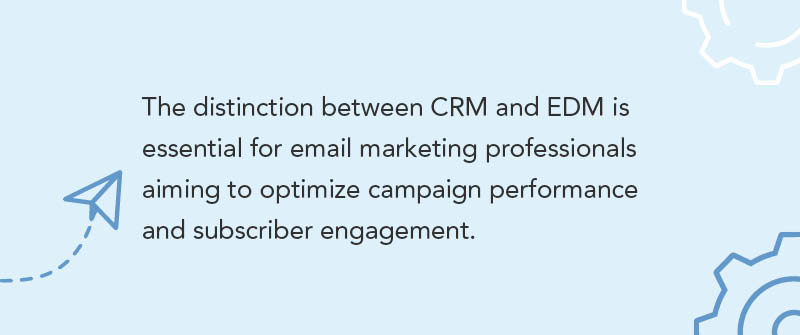
What Are Examples of CRM-Enabled EDM Marketing?
There are countless EDM marketing examples where CRM acts as the engine for deeper engagement. Take, for example, a subscription service that sends renewal reminders or loyalty perks only to subscribers approaching their term limits based on CRM data. Similarly, a B2B software provider might nurture leads through a series of onboarding tutorials, which include onboarding emails and a dedicated onboarding email to guide new users, as well as follow up email sequences to maintain engagement after the initial onboarding process. These onboarding emails are a crucial part of drip email campaigns, helping to establish a positive first impression and improve user engagement. Drip emails and drip email campaigns, powered by CRM data, are used to nurture leads, build relationships, and drive conversions through targeted, automated sequences. Drip email marketing is highly effective for building long-term customer relationships and advancing prospects through the sales cycle. These campaigns aren’t just more efficient; they also yield higher open and conversion rates because they’re grounded in real-world customer insights.
How Should Marketers Choose the Right Tools for Their Business Goals?
Selecting the right technology is crucial. Marketers should assess both their CRM and email marketing software solutions on data quality, integration capabilities, ease of use, and the granularity of actionable insights provided. Choosing the right email marketing software is essential for automating targeted campaigns, analyzing performance, and streamlining communication. A best-in-class pairing, such as a robust CRM and AudiencePoint, empowers marketing teams and the sales team to go beyond basic blasts and toward sophisticated lifecycle marketing. These tools can help prepare leads, support the sales team throughout the sales cycle, and boost sales by improving targeting and engagement. Look for platforms that offer real-time feedback on inbox placement and engagement, as well as the ability to auto-suppress unengaged or problematic addresses informed by large-scale data benchmarks. This ensures deliverability improvements and ultimately drives revenue growth.
To maximize impact, coordinate your entire campaign across channels—integrating email marketing, social media, and community engagement for cohesive messaging and better results.
Ready to connect your CRM power with advanced EDM strategies that close the gap between data and engagement? Discover how AudiencePoint’s insights—powered by trillions of real subscriber signals—enable data-driven segmentation, maximized deliverability, and smarter campaigns. Don’t let outdated tactics hold your email program back; schedule a demo with AudiencePoint to see measurable upgrades in your ROI, inbox placement, and subscriber reactivation rates.

